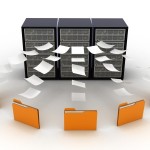A paperless office is one of the simplest ways a company can minimize clutter and mess, and also help contribute to making business operations more green and environment friendly. Having a paperless office essentially means drastically decreasing the use and consumption of paper in the office. Of course there will always be a need to use paper for some things, but reducing the paper you consume can save you a lot of money and at the same time help the environment. There are many ways to go about doing this. One is to invest in equipment and technologies to make paper use more efficient for when you do need to use it – for example, printers that allow you to print on both sides or scale down images. Here are some other actions you can take: Digitize your hardcopy files so that you have soft copies as well as reliable backups. Assess which paper records you can recycle (or shred then recycle) – this also reduces your document storage space. Release online memos instructing people to avoid or eliminate unnecessary printouts (such as printer test pages). Send web links through email or IM instead of printing a webpage to share. Distribute presentations on flash drives instead of printing them for your audience, or use websites such as SlideShare.com that allow you to share online. When you use less paper, you save on paper and printer ink costs. Minimizing the paper you store also saves you valuable office space. In fact, one company saved $30 million in lease costs when they went paperless. Of course, we can’t really completely eliminate our use of paper. But even small changes can go a long way toward a paperless office and healthier environment – and lower operating costs. Resources: http://156.98.19.245/workplace/index.html http://www.microsoft.com/smallbusiness/resources/technology/communications/6-tips-for-a-paperless-office.aspx#tipsforapaperlessoffice http://www.ismckenzie.com/eight-ways-to-eliminate-paper-and-clutter-in-your-office/
 A paperless office is one of the simplest ways a company can minimize clutter and mess, and also help contribute to making business operations more green and environment friendly.
A paperless office is one of the simplest ways a company can minimize clutter and mess, and also help contribute to making business operations more green and environment friendly.
Having a paperless office essentially means drastically decreasing the use and consumption of paper in the office. Of course there will always be a need to use paper for some things, but reducing the paper you consume can save you a lot of money and at the same time help the environment.
There are many ways to go about doing this. One is to invest in equipment and technologies to make paper use more efficient for when you do need to use it – for example, printers that allow you to print on both sides or scale down images.
Here are some other actions you can take:
- Digitize your hardcopy files so that you have soft copies as well as reliable backups.
- Assess which paper records you can recycle (or shred then recycle) – this also reduces your document storage space.
- Release online memos instructing people to avoid or eliminate unnecessary printouts (such as printer test pages).
- Send web links through email or IM instead of printing a webpage to share.
- Distribute presentations on flash drives instead of printing them for your audience, or use websites such as SlideShare.com that allow you to share online.
When you use less paper, you save on paper and printer ink costs. Minimizing the paper you store also saves you valuable office space. In fact, one company saved $30 million in lease costs when they went paperless.
Of course, we can’t really completely eliminate our use of paper. But even small changes can go a long way toward a paperless office and healthier environment – and lower operating costs.
Resources:
http://156.98.19.245/workplace/index.html
http://www.ismckenzie.com/eight-ways-to-eliminate-paper-and-clutter-in-your-office/

